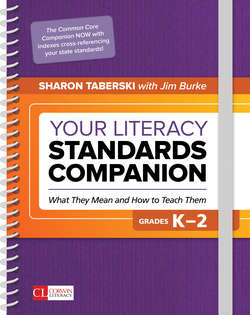Читать книгу Your Literacy Standards Companion, Grades K-2 - Jim Burke - Страница 45
Grades K–2 Common Core Reading Standard 3: What the Teacher Does
ОглавлениеTo help students identify the characters, setting, and major events in a story:
Read aloud and share texts whose story elements and/or organization are straightforward and a good fit with the story elements you’re highlighting. Look for traditionally organized stories, such as “The Three Billy Goats Gruff” and Rosemary Wells’s Timothy Goes to School, and use story map graphic organizers to chart the stories’ development (resources.corwin.com/literacycompanionk-2).
Make a list of all the characters in a story and determine which is the main character and which ones play more of a supporting role. Elicit from students why they categorize the characters as they do, and direct them back to the text for evidence.
Create character webs to help students identify what the main and supporting characters are like, how they feel, and what motivates them to behave in certain ways. As students read the text, help them draw connections between the characters, for example, between the hardworking Little Red Hen and the lazy Dog, Duck, and Pig. Help students identify how the Little Red Hen’s request for help and Dog’s, Duck’s, and Pig’s refusal to help lead her to act as she does at the end.
Help students understand that setting refers to both where (city, country, in school, at home, and so on) and when (time of day or season) a story takes place. This also includes the geographic and/or historical location of the story. Help students keep track of any changes in the setting of the story and help them identify the words the author uses to alert them to such changes.
To help students describe and explain how characters respond to major events and challenges:
Have students identify the wants or needs of key characters and parts of the story where their various wants and needs conflict. Examine what those conflicts reveal about the characters.
On a second reading, build a major events (plot) map with students to record the most important happenings. Illustrate how a plot builds. Have students identify the turning point in the story. Lead them in a discussion of what came before and after (resources.corwin.com/literacycompanionk-2).
As you read a picture book a second time, invite students to hold up yellow sticky notes to signal major moments in the story. Pause to have them examine the illustration that depicts the scene and describe how the character is behaving, and why. Continue this activity until the story’s end. Help them notice whether or not characters typically act in certain ways.
Create a three-column chart with students that you can add to over the year, listing the main character’s name, a personality trait, and whether or not the character changes by the end of story. Doing so helps children see that in some stories the main character does change, while in others the author has the character stay the same on purpose (e.g., Curious George, Amelia Bedelia, Judy Moody, Clifford, Spinky in Spinky Sulks).
To help students describe how individuals, events, ideas, and pieces of information relate to one another:
Select a portion of a text and model how you absorb each sentence, noticing when two things connect in a particularly striking, important way. (For example, in a book about rain forest animals, you might note the connection between a parrot’s brightly colored feathers, camouflage, and the concept of predator/prey. In a biography of Jackie Robinson, Robinson and the owner of the Brooklyn Dodgers, Branch Rickey, have a significant connection because Rickey dared to break the Major League Baseball color barrier by allowing Robinson to play.)
Help students identify language that lets them know two pieces of information, ideas, concepts, or events are being compared (but, however, in contrast, versus). Likewise, help them identify words that signal the information is organized in a sequence (first, next, and then).
To help students describe the connection between historical events, scientific ideas or concepts, or steps in technical procedures:
Help students determine why something happened as it did. This will help them begin to identify cause/effect relationships between concepts, people, and events.
Gather a few texts that offer different and clear examples of signal words. Read the texts and chart the signal words, posting them on the wall for student reference. For example, some authors use timelines, dates, numbered steps, and words like first, second, next, last, most important, and years ago.
To help your English language learners, try this:
Guide a small group of students through a basic story in which the story elements are obvious and unambiguous. If students don’t each have their own copy of the story, use an enlarged text. Wordless books offer students the opportunity to focus on the story elements shown in the illustrations.
Provide students with a story structure graphic organizer and have them discuss the story elements and fill them in as you or they read. For nonfiction text, use a graphic organizer that matches the text structure and fill in the organizer as you read or discuss the text.
Make certain students understand the academic vocabulary you’re using, such as main character, problem, and resolution, and for nonfiction text, main idea and details.
Developmental Debrief:
Nascent readers typically focus more on the plot than on the characters. The teacher, therefore, is instrumental in helping students make the move from focusing on the plot to attending to how and why the characters behave as they do. Select read-aloud and shared-reading texts with multidimensional characters and guide students to recognize how the characters’ personality traits and ways of thinking or acting ultimately affect how the story turns out.
